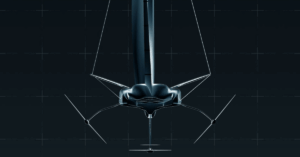
Video: Deadly Fire Erupts On Oil Tanker During Repairs In Indonesia, Four Killed
June 26, 2025
US Allows Ethane Shipments To China But Blocks Unloading Without Approval
June 26, 2025

Italian luxury sports car manufacturer, Ferrari, has officially announced its entry into offshore sailing with a groundbreaking project called Hypersail, a 100-foot flying monohull yacht.
The vessel is currently under construction at an undisclosed location in Italy and is expected to be launched in 2026.
The Hypersail yacht stands out as the world’s first ocean racing monohull of its size, designed to be entirely energy self-sufficient. It will operate without any combustion engine onboard, using only solar, wind, and kinetic energy to power all its systems, including foil movement, rudder and keel control, and onboard electronics.
Led by Team Principal Giovanni Soldini, a seasoned sailor with over three decades of solo and crewed ocean racing experience, the Hypersail project brings together Ferrari’s automotive expertise with top-level nautical design.
The yacht has been designed by acclaimed French naval architect Guillaume Verdier, known for his work on high-performance vessels. One of the most striking features of the yacht is its ability to “fly” above water by stabilising on three contact points.
The configuration includes a canting keel that also acts as a foil-a unique approach never used before, along with a rudder foil and two alternating side foils. This design allows the yacht to achieve high speeds while minimising drag.
Ferrari Chairman John Elkann explained that the project is deeply inspired by the endurance spirit of the company’s Hypercar, which has recently won the 24 Hours of Le Mans three years in a row. He described offshore sailing as an ultimate test of endurance, and emphasised that the Hypersail project fits perfectly into Ferrari’s tradition of pushing boundaries.
According to Ferrari, the project is not aimed at competitions like the America’s Cup, which is bound by strict technical regulations. Elkann clarified that Hypersail is meant to break free of such limits, allowing Ferrari to experiment with radical ideas and explore new technological frontiers.
Although no specific sporting events have been confirmed yet, the yacht’s development is being taken step by step. Soldini stated that while the goal is to get the vessel on water by 2026, the team will first focus on completing construction, testing, and debugging. He added that setting competitive targets at this stage would be premature due to the complexity of the project.
Currently, 20 people are working full time on Hypersail, supported by an additional 80 to 90 specialists. Ferrari’s Chief Financial Officer, Antonio Picca Piccon, said that the project is fully planned financially and will not impact the company’s capital expenditure.
The yacht’s energy autonomy presents one of its most significant challenges. Since long ocean races offer no chance for pit stops or external support, the vessel’s onboard systems have to generate all the energy needed while still delivering top-level performance. To meet this challenge, the team has worked hard to optimise every component for energy efficiency and carefully manage all available power onboard.
Giovanni Soldini said that they’re focused on delivering both extreme performance and total reliability, especially given the unpredictable and often harsh conditions of open sea sailing.
Ferrari has also integrated a flight control system into the yacht, borrowing heavily from its experience in building high-performance cars like the F80. The control systems rely on complex aerodynamic and structural calculations to keep the yacht stable and safe even at high speeds for extended durations.
As part of its commitment to innovation, Ferrari has already filed nine patents related to the Hypersail project, with six more currently in the works. The company says this isn’t just about designing a high-tech boat-it’s also helping Ferrari grow in automotive engineering by transferring technology and insights between land and sea.
They call it “open innovation,” meaning they’re actively working with outside partners and suppliers to bring in fresh ideas and expertise. The technology being developed spans multiple areas, including aerodynamics, energy management, and power systems.
Soldini said he’s proud to be part of such a pioneering venture, describing it as an exciting blend of different fields. He added that Ferrari’s involvement in system design is leading to the development of onboard technology never before seen in the sailing world.
The yacht’s racing crew is expected to be small, just 8 to 12 people, to keep the vessel light, fast, and efficient during competitions.
Ferrari says Hypersail is more than just a new race boat. It’s a bold vision to rethink what’s possible at sea-combining endurance, innovation, and sustainable engineering in one sleek, futuristic vessel.
Reference: Ferrari
Source: Maritime Shipping News


